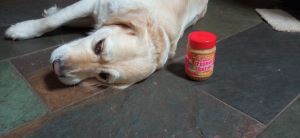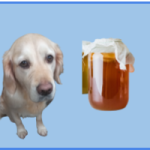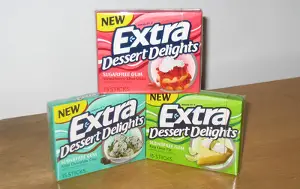
Peanut butter is a nutty treat that can, indeed, drive dogs nuts.
With its stinky aroma and rich flavor, peanut butter is a favorite for many dogs, including my own.
Because the treat has so many natural vitamins and nutrients, it’s a great supplement for dogs that can be used in a variety of ways.
Most dogs love this tasty snack and look forward to the delicacy. But why do dogs love it so much?
And is it good for them?
To start, I want to look at why peanut butter is such a popular tool in a dog owner’s tool box.
What are the main ways that peanut butter is used with dogs?
Peanut butter can be used for lots of reasons.
Having a hard time getting your dog to take a pill? Peanut butter is a great way to hide medications.
Vets often recommend using a small dab of peanut butter and hiding the pill inside.
Because the peanut butter has such a strong flavor and is sticky, most dogs are often tricked into taking their medication before even realizing that there was a pill inside.
One of my favorite ways to use this trick is to put the peanut butter inside a small piece of bread.
My Golden Retriever enjoys this treat so much that getting her pills becomes a game instead of a chore.
Peanut butter can also be used for canine enrichment.
Many dogs suffer from boredom, particularly in bad weather, or when their owners are working.
Because dogs need mental stimulation, they will often choose these opportunities to create trouble and wreak havoc on your furniture, your mail, or even their favorite toys.
To alleviate this boredom, you can give your dog a bit of peanut butter inside of a Kong toy to keep them busy. Licking and chewing alleviates stress and keeps dogs happy and healthy.
If you don’t have a Kong at home, another great option is a Licki Mat, a washable silicone mat with small indents in it.
These can be found at most major pet stores and are a great alternative for dogs with soft mouths that don’t like normal toys.
So, we have established that peanut butter is a very versatile substance and that it can be used in a whole variety of ways with our dogs, this doesn’t really help the owners of dogs who can’t abide peanut butter.
So, just how many dogs like eating this spread?
Is it normal for a dog to not like peanut butter?
In a recent survey of dog owners, the AKC reported that 73% of dogs were addicted to peanut butter.
No. I’m joking of course.
There is no scientific proof about how popular peanut butter is amongst dogs.
Probably more dogs like it than dislike it because after all we are talking about dogs here.
But there must be a significant number of dogs who would rather cut their paws off than touch that stuff.
And many of these will be smaller breed dogs or toy breeds because they can be very picky eaters.
If your dog doesn’t like peanut butter, you can still try other alternatives to entertain your dog. And I will talk about those in a later section.
Having found out that your dog isn’t the strangest and weirdest canine in the world, our next stop is to look at what possible health benefits peanut butter can provide our dogs with…
Why is peanut butter a healthy treat to give your dog?
One of the many reasons I love giving peanut butter to my dog is because of all of the health benefits it offers.
Peanut butter is an excellent source of heart-healthy fats and protein. It also is loaded with vitamins and nutrients like vitamin B, niacin, and vitamin E.
Nutrients like vitamin B are essential in a dog’s diet—it helps the assimilation of protein and fat.
Similarly, vitamin E helps with metabolic processes that create energy in the body.
While most dogs don’t have any deficiencies in these vitamins, peanut butter is a great way to supplement your dog’s daily diet and give them a little bit of extra nutrients.
For every positive there must be a negative, right? So just what is the “dark side” of peanut butter?
Why is peanut butter an unhealthy treat to give your dog?
Although it tastes good, peanut butter should only be given to dogs in moderation. Peanut butter can be high in calories and protein.
Because dogs have different metabolic needs than humans, this can cause problems in their daily diet.
An excess of any new treat can also cause dietary upset like vomiting or diarrhea.
If you notice your dog dealing with stomach upset after consuming peanut butter, be sure to contact your vet to ensure your dog’s safety.
Next I want to provide you with some ideas of what you can do with a dog that doesn’t like peanut butter.
And there ain’t no rocket science to it!
What should I do if my dog doesn’t like peanut butter?
If your dog doesn’t like peanut butter, don’t stress!
You actually have two options that you can pursue.
The first option is to find an alternative.
Although peanut butter is sticky and smelly, there are other alternatives that some dogs enjoy just as much, if not more.
One of these alternatives might be a better option for a dog that doesn’t enjoy the tasty treat.
And in the next section I discuss a couple of substitutes that you might want to try with your dog.
Your second option is get your dog to like peanut butter.
Are you up for the challenge?!
One of the most obvious ways of wooing your dog with peanut butter is to add it into their main meal but only add tiny amounts at first.
Another way is to spread a tiny bit of peanut butter onto their favourite treat.
I mean it could be that your dog hates peanut butter not because of its taste but because it only gets to eat peanut butter when you are trying to hide that disgusting medication in it.
If your dog has found you out perhaps you should use peanut butter in a more positive way.
Not as a cover for those bitter tasting pills but as a reward for playing with a Kong toy.
But, if the challenge of getting your dog to fall in love with peanut butter proves to be “a bridge too far” then don’t continue to flog a dead horse.
Instead, try an alternative.
And as it happens, I have a couple of suggestions up my sleeve…
What are the best alternatives to peanut butter?
One of the best alternatives that I have found to peanut butter is canned pumpkin. 100% pumpkin can be found, canned, in your local grocery store-sometimes even in the same aisle as the peanut butter.
It’s often cheaper than peanut butter and it’s filled with fiber, which helps many dogs with digestive upset.
Pumpkin is also rich in potassium and iron, which is great for controlling blood pressure and keeping your dog’s cardiovascular system healthy.
Best of all, the treat has a very similar consistency to peanut butter and can be used in the same ways.
If your dog isn’t a big fan of peanut butter, you can also try plain yogurt.
One of my dogs is a poodle mix and has terrible allergies, which means he can’t have foods that most other dogs can.
Yogurt is one of his absolute favorite treats and it can be used to hide pills, when he needs to take them.
Yogurt is also great frozen, which makes it a perfect treat for canine enrichment on hot days.
If you have an ice cube tray, mix it with a little canned pumpkin and freeze it for a few hours—your dog will thank you!
When is peanut butter poisonous to dogs?
Although peanut butter is a delicious treat that is mostly safe for dogs, there is one way it can cause some problems.
In recent years, many companies have decided to start changing the sugar level in peanut butter to try and reduce the amount of sugar in the product for those on a diet.
However, the alternative is a substance that is deadly to dogs.
This material, Xylitol, isn’t found in most brands of peanut butter, but it can be found on the shelves.
Some of the brands that use this ingredient are Go Nuts Co, Krush Nutrition, Nuts ‘N More, and P28.
While these are only a few brands that use Xylitol, it’s important to read every label to make sure that the ingredient is far away from your dog—it is toxic.
The increasing popularity of Xylitol has brought many other additives to peanut butter, as well.
Some common peanut butter brands also include increasing amounts of chemicals to preserve the product.
Stay away from labels that have a long list of ingredients as these additives can be harmful.
What are dog friendly brands of peanut butter?
When you’re looking for a peanut butter product for your dog, one of the first places I like to check is the pet store.
There are a few products that are made specifically for dogs that contain healthy supplements to their normal diet.
One of these brands is Dilly’s Poochie Butter. It can be bought on Amazon and shipped right to your front door.
If you prefer to go shopping at your local grocery store, keep an eye out for products that claim to be all natural or organic.
Many of these peanut butter brands include only peanuts and trace amounts of oil, which are dog friendly in moderation.
Can some dogs be allergic to peanut butter?
Like humans, dogs can be allergic to nuts. While peanut butter isn’t a common allergy in dogs, like it is in humans, dogs can still be allergic to it.
If your dog has never had peanut butter before, it’s especially important to give them a very small amount to start off with.
Some symptoms of an allergy to peanut butter in dogs is itchiness, redness, and scratching.
If you notice any of these symptoms, changes in breathing, swelling, or dietary discomfort, call your vet immediately.
Closing Thoughts
Peanut butter can be a fantastic snack for dogs, if given in moderation.
When used for mental stimulation and to hide medication, peanut butter can be a lifesaver for busy dog owners.
If peanut butter is a favorite of your own dogs, be sure to check the label for additives that can be dangerous, like the ingredient, Xylitol.
Owners should also look out for any signs of allergy or general stomach discomfort.
If your dog shows any signs of itchiness, redness, or vomiting, be sure to contact your vet’s office immediately.






